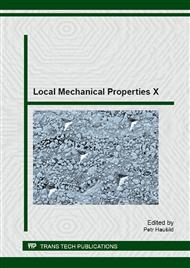[1]
H.G. Elias, An Introduction to Plastics, 2nd ed., Wiley-VCH GmbH & Co. KGaA, Weinheim, (2003).
Google Scholar
[2]
Z. Majer, L. Náhlík and P. Hutař, The estimation of micro-crack behavior in polymer particulate composite with soft interphase, Adv. Mat. R. 482-484 (2012) 1660-1663.
DOI: 10.4028/www.scientific.net/amr.482-484.1660
Google Scholar
[3]
Y.S. Thio, A.S. Argon, R.E. Cohen and M. Weinberg, Toughening of isotatic polypropylene with CaCO3 particles, Polymer 43 (2002) 3661-3674.
DOI: 10.1016/s0032-3861(02)00193-3
Google Scholar
[4]
Z. Majer, P. Hutař and L. Náhlík, Determination of the Effect of Interphase on the Fracture Toughness and Stiffness of a Particulate Polymer Composite, Mech. of Comp. Mat. 49 (2013) 475-482.
DOI: 10.1007/s11029-013-9364-0
Google Scholar
[5]
Z. Majer and E. Novotná, The effect of various non-linear matrix types on mechanical properties of particulate composite, CHEMICKE LISTY 105 (2011) 830-831.
Google Scholar
[6]
F.N. Ahmad, M. Jaafar, S. Palaniandy and K.A.M. Azizli, Effect of particle shape of silica mineral on the properties of epoxy composites, Comp. Sc. and Tech. 68 (2008) 346-353.
DOI: 10.1016/j.compscitech.2007.07.015
Google Scholar
[7]
I.L. Dubnikova, V.G. Oshmyan and A.Y. Gorenberg, Mechanisms of particulate filled polypropylene finite plastic deformation and fracture, J. of Mat. Sc. 32 (1997) 1613–1622.
Google Scholar
[8]
Z. Majer, Load influence on the behavior of micro-crack in the particulate composite, Key Eng. Mat. 525-526 (2012) 173-176.
DOI: 10.4028/www.scientific.net/kem.525-526.173
Google Scholar
[9]
G. Levita, A. Marchetti and A. Lazzeri, Fracture of ultrafine calcium carbonate/polypropylene composites, Polym. Comp. 10 (1989) 39–43.
DOI: 10.1002/pc.750100106
Google Scholar
[10]
Z. Majer and P. Hutař, The effect of nonlinear matrix on crack propagation in the particulate composite, Key Eng. Mat. 488-489 (2012) 484-487.
DOI: 10.4028/www.scientific.net/kem.488-489.484
Google Scholar
[11]
Z. Majer and L. Náhlík, Micro-crack behaviour in polymer matrix of particulate composite: Influence of non-linear matrix, CHEMICKE LISTY 106 (2012) 472-473.
Google Scholar
[12]
Z. Demjen, B. Pukanszky and J. Nagy, Evaluation of interfacial interaction in polypropylene/ surface treated CaCO3 composites, Composites 29A (1998) 323–329.
DOI: 10.1016/s1359-835x(97)00032-8
Google Scholar
[13]
J. Moczo, E. Fekete and B. Pukanszky, Acid-base interactions and interphase formation in particulate-filled polymers, J. Adhesion 78 (2002) 861-875.
DOI: 10.1080/00218460214099
Google Scholar
[14]
B. Pukánszky, Interfaces and interphases in multicomponent materials: past, present, future, Eur. Pol. J. 41 (2005) 645-662.
DOI: 10.1016/j.eurpolymj.2004.10.035
Google Scholar
[15]
F. Erdogan and G.C. Sih, On the crack extension in plates under plane loading and transverse shear, J. of Fluids Eng. 85 (1963) 519-527.
DOI: 10.1115/1.3656897
Google Scholar


